Business Strategy Analysis of Klarna: UK Market and Beyond
VerifiedAdded on 2023/01/12
|17
|4741
|79
Report
AI Summary
This report provides a comprehensive analysis of Klarna's business strategy within the UK market. It begins with an introduction to business strategy and an overview of Klarna's services. The report then applies the PESTEL framework and stakeholder analysis to examine the macro environment. It analyzes the internal environment using VRIO and McKinsey's 7S model to assess resources and capabilities. Finally, it employs Porter's Five Forces model to evaluate the competitive landscape. The report concludes with a strategic management plan, offering insights into Klarna's competitive positioning and future growth opportunities. The analysis covers political, economic, social, technological, environmental, and legal factors, as well as internal resources and organizational structures. It also assesses competitive forces within the banking sector, offering a complete perspective on Klarna's strategic approach.
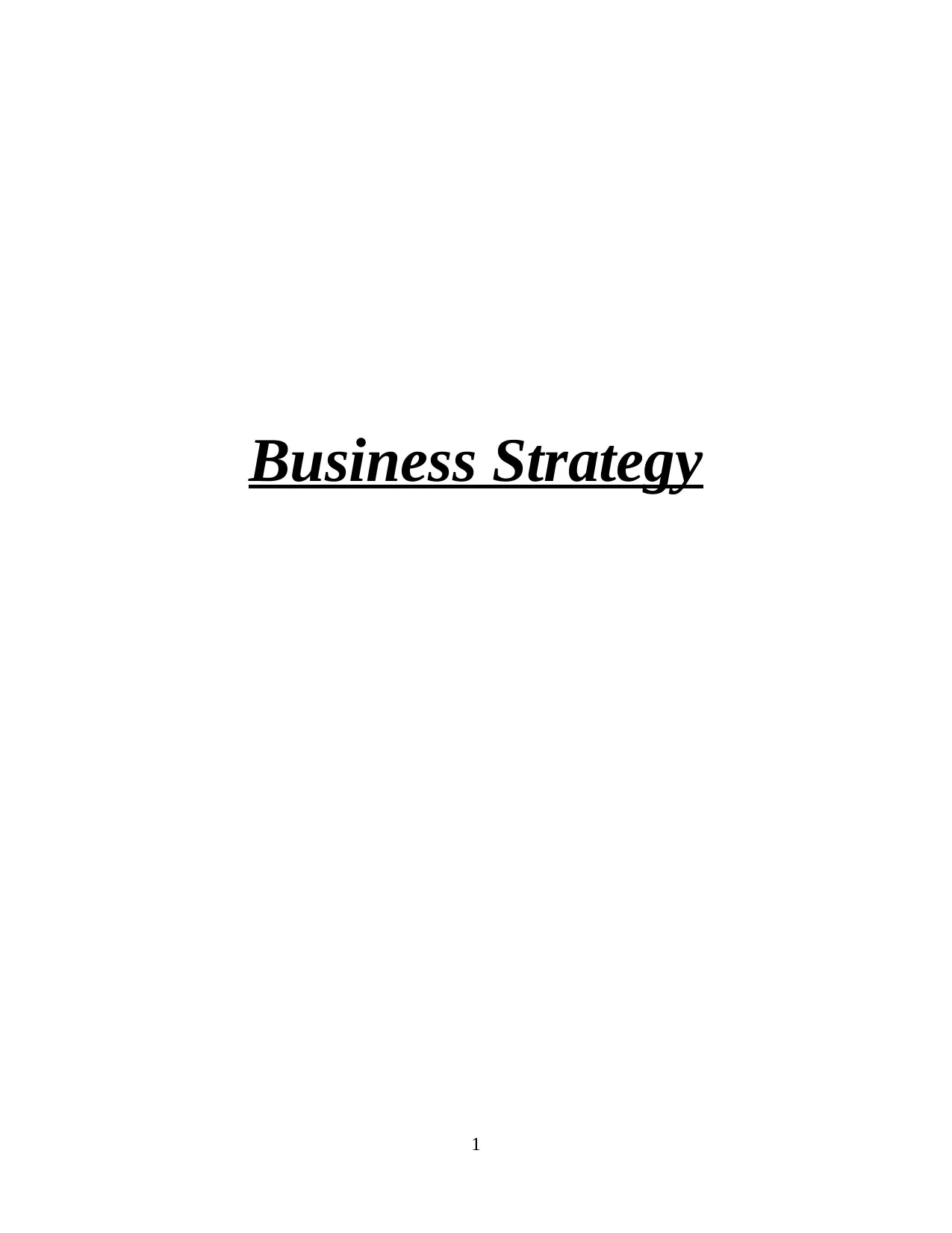
Business Strategy
1
1
Paraphrase This Document
Need a fresh take? Get an instant paraphrase of this document with our AI Paraphraser
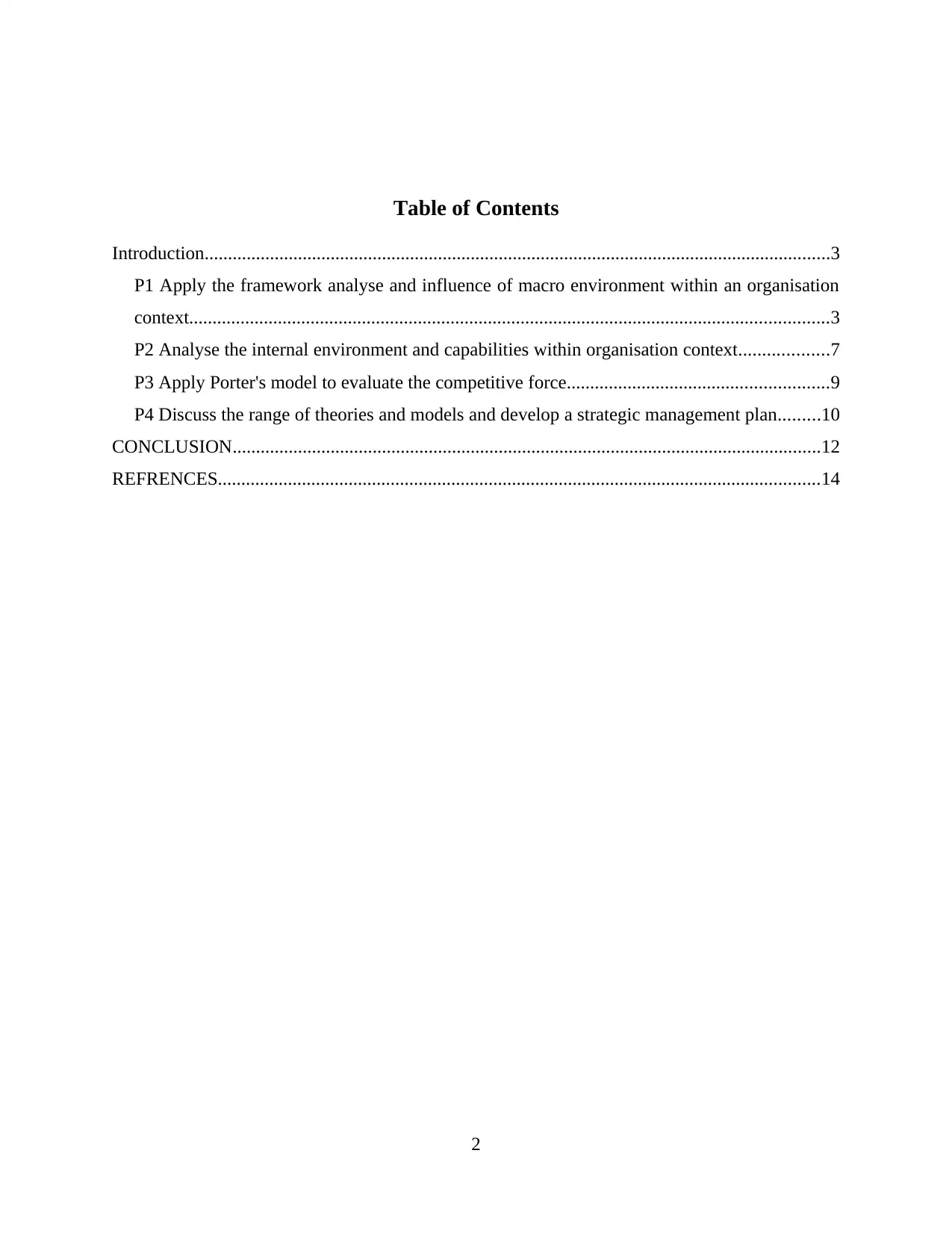
Table of Contents
Introduction......................................................................................................................................3
P1 Apply the framework analyse and influence of macro environment within an organisation
context.........................................................................................................................................3
P2 Analyse the internal environment and capabilities within organisation context...................7
P3 Apply Porter's model to evaluate the competitive force........................................................9
P4 Discuss the range of theories and models and develop a strategic management plan.........10
CONCLUSION..............................................................................................................................12
REFRENCES.................................................................................................................................14
2
Introduction......................................................................................................................................3
P1 Apply the framework analyse and influence of macro environment within an organisation
context.........................................................................................................................................3
P2 Analyse the internal environment and capabilities within organisation context...................7
P3 Apply Porter's model to evaluate the competitive force........................................................9
P4 Discuss the range of theories and models and develop a strategic management plan.........10
CONCLUSION..............................................................................................................................12
REFRENCES.................................................................................................................................14
2
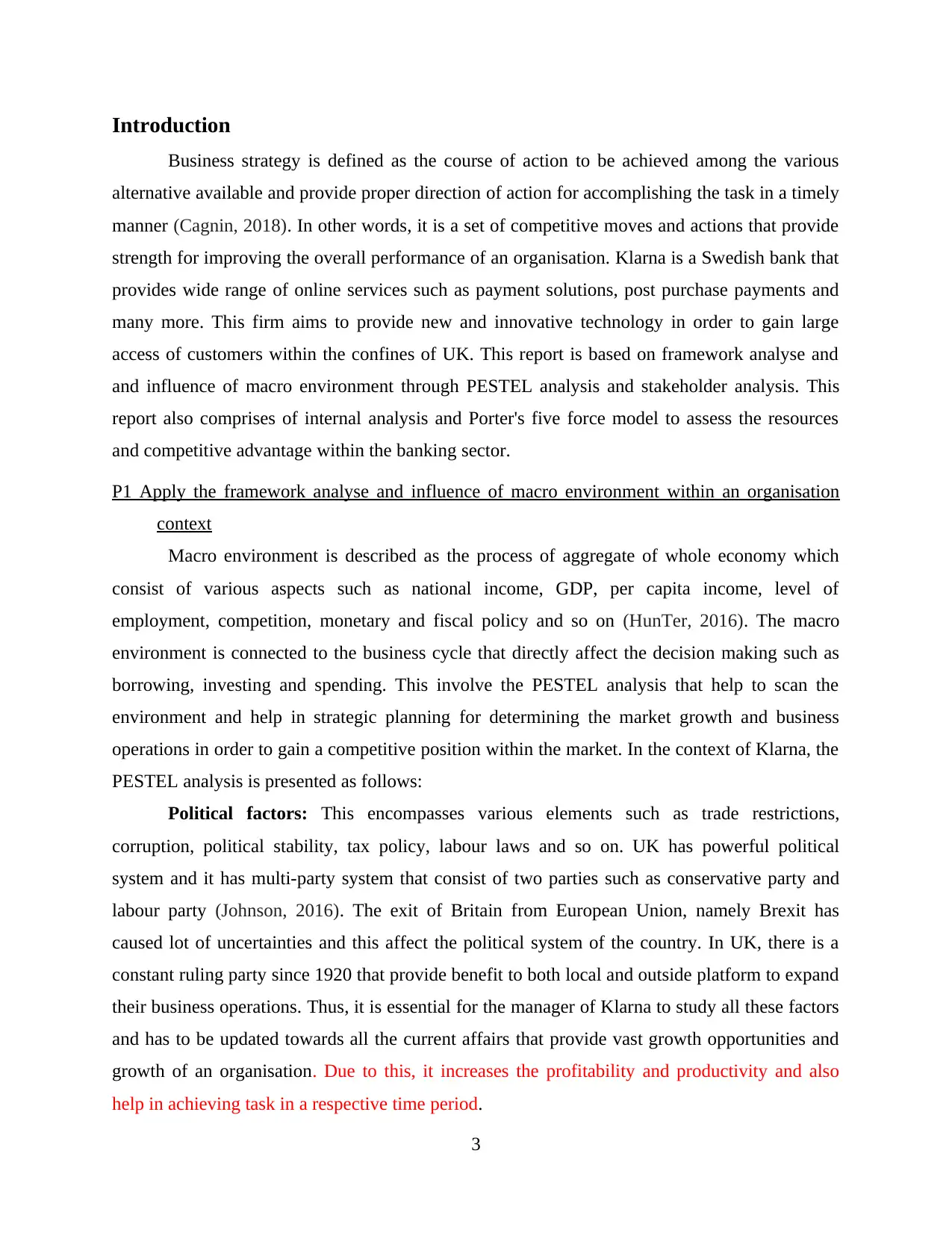
Introduction
Business strategy is defined as the course of action to be achieved among the various
alternative available and provide proper direction of action for accomplishing the task in a timely
manner (Cagnin, 2018). In other words, it is a set of competitive moves and actions that provide
strength for improving the overall performance of an organisation. Klarna is a Swedish bank that
provides wide range of online services such as payment solutions, post purchase payments and
many more. This firm aims to provide new and innovative technology in order to gain large
access of customers within the confines of UK. This report is based on framework analyse and
and influence of macro environment through PESTEL analysis and stakeholder analysis. This
report also comprises of internal analysis and Porter's five force model to assess the resources
and competitive advantage within the banking sector.
P1 Apply the framework analyse and influence of macro environment within an organisation
context
Macro environment is described as the process of aggregate of whole economy which
consist of various aspects such as national income, GDP, per capita income, level of
employment, competition, monetary and fiscal policy and so on (HunTer, 2016). The macro
environment is connected to the business cycle that directly affect the decision making such as
borrowing, investing and spending. This involve the PESTEL analysis that help to scan the
environment and help in strategic planning for determining the market growth and business
operations in order to gain a competitive position within the market. In the context of Klarna, the
PESTEL analysis is presented as follows:
Political factors: This encompasses various elements such as trade restrictions,
corruption, political stability, tax policy, labour laws and so on. UK has powerful political
system and it has multi-party system that consist of two parties such as conservative party and
labour party (Johnson, 2016). The exit of Britain from European Union, namely Brexit has
caused lot of uncertainties and this affect the political system of the country. In UK, there is a
constant ruling party since 1920 that provide benefit to both local and outside platform to expand
their business operations. Thus, it is essential for the manager of Klarna to study all these factors
and has to be updated towards all the current affairs that provide vast growth opportunities and
growth of an organisation. Due to this, it increases the profitability and productivity and also
help in achieving task in a respective time period.
3
Business strategy is defined as the course of action to be achieved among the various
alternative available and provide proper direction of action for accomplishing the task in a timely
manner (Cagnin, 2018). In other words, it is a set of competitive moves and actions that provide
strength for improving the overall performance of an organisation. Klarna is a Swedish bank that
provides wide range of online services such as payment solutions, post purchase payments and
many more. This firm aims to provide new and innovative technology in order to gain large
access of customers within the confines of UK. This report is based on framework analyse and
and influence of macro environment through PESTEL analysis and stakeholder analysis. This
report also comprises of internal analysis and Porter's five force model to assess the resources
and competitive advantage within the banking sector.
P1 Apply the framework analyse and influence of macro environment within an organisation
context
Macro environment is described as the process of aggregate of whole economy which
consist of various aspects such as national income, GDP, per capita income, level of
employment, competition, monetary and fiscal policy and so on (HunTer, 2016). The macro
environment is connected to the business cycle that directly affect the decision making such as
borrowing, investing and spending. This involve the PESTEL analysis that help to scan the
environment and help in strategic planning for determining the market growth and business
operations in order to gain a competitive position within the market. In the context of Klarna, the
PESTEL analysis is presented as follows:
Political factors: This encompasses various elements such as trade restrictions,
corruption, political stability, tax policy, labour laws and so on. UK has powerful political
system and it has multi-party system that consist of two parties such as conservative party and
labour party (Johnson, 2016). The exit of Britain from European Union, namely Brexit has
caused lot of uncertainties and this affect the political system of the country. In UK, there is a
constant ruling party since 1920 that provide benefit to both local and outside platform to expand
their business operations. Thus, it is essential for the manager of Klarna to study all these factors
and has to be updated towards all the current affairs that provide vast growth opportunities and
growth of an organisation. Due to this, it increases the profitability and productivity and also
help in achieving task in a respective time period.
3
⊘ This is a preview!⊘
Do you want full access?
Subscribe today to unlock all pages.

Trusted by 1+ million students worldwide
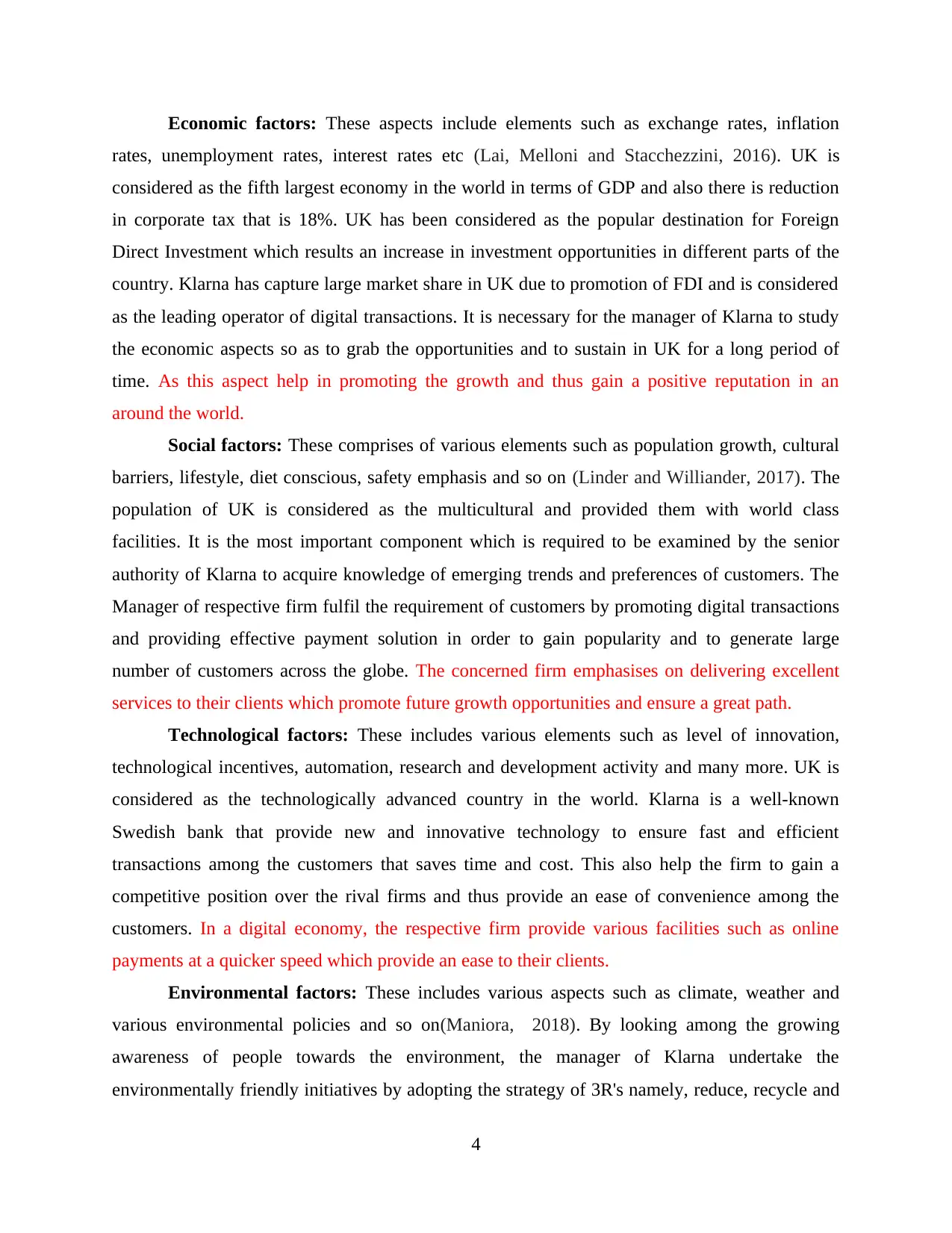
Economic factors: These aspects include elements such as exchange rates, inflation
rates, unemployment rates, interest rates etc (Lai, Melloni and Stacchezzini, 2016). UK is
considered as the fifth largest economy in the world in terms of GDP and also there is reduction
in corporate tax that is 18%. UK has been considered as the popular destination for Foreign
Direct Investment which results an increase in investment opportunities in different parts of the
country. Klarna has capture large market share in UK due to promotion of FDI and is considered
as the leading operator of digital transactions. It is necessary for the manager of Klarna to study
the economic aspects so as to grab the opportunities and to sustain in UK for a long period of
time. As this aspect help in promoting the growth and thus gain a positive reputation in an
around the world.
Social factors: These comprises of various elements such as population growth, cultural
barriers, lifestyle, diet conscious, safety emphasis and so on (Linder and Williander, 2017). The
population of UK is considered as the multicultural and provided them with world class
facilities. It is the most important component which is required to be examined by the senior
authority of Klarna to acquire knowledge of emerging trends and preferences of customers. The
Manager of respective firm fulfil the requirement of customers by promoting digital transactions
and providing effective payment solution in order to gain popularity and to generate large
number of customers across the globe. The concerned firm emphasises on delivering excellent
services to their clients which promote future growth opportunities and ensure a great path.
Technological factors: These includes various elements such as level of innovation,
technological incentives, automation, research and development activity and many more. UK is
considered as the technologically advanced country in the world. Klarna is a well-known
Swedish bank that provide new and innovative technology to ensure fast and efficient
transactions among the customers that saves time and cost. This also help the firm to gain a
competitive position over the rival firms and thus provide an ease of convenience among the
customers. In a digital economy, the respective firm provide various facilities such as online
payments at a quicker speed which provide an ease to their clients.
Environmental factors: These includes various aspects such as climate, weather and
various environmental policies and so on(Maniora, 2018). By looking among the growing
awareness of people towards the environment, the manager of Klarna undertake the
environmentally friendly initiatives by adopting the strategy of 3R's namely, reduce, recycle and
4
rates, unemployment rates, interest rates etc (Lai, Melloni and Stacchezzini, 2016). UK is
considered as the fifth largest economy in the world in terms of GDP and also there is reduction
in corporate tax that is 18%. UK has been considered as the popular destination for Foreign
Direct Investment which results an increase in investment opportunities in different parts of the
country. Klarna has capture large market share in UK due to promotion of FDI and is considered
as the leading operator of digital transactions. It is necessary for the manager of Klarna to study
the economic aspects so as to grab the opportunities and to sustain in UK for a long period of
time. As this aspect help in promoting the growth and thus gain a positive reputation in an
around the world.
Social factors: These comprises of various elements such as population growth, cultural
barriers, lifestyle, diet conscious, safety emphasis and so on (Linder and Williander, 2017). The
population of UK is considered as the multicultural and provided them with world class
facilities. It is the most important component which is required to be examined by the senior
authority of Klarna to acquire knowledge of emerging trends and preferences of customers. The
Manager of respective firm fulfil the requirement of customers by promoting digital transactions
and providing effective payment solution in order to gain popularity and to generate large
number of customers across the globe. The concerned firm emphasises on delivering excellent
services to their clients which promote future growth opportunities and ensure a great path.
Technological factors: These includes various elements such as level of innovation,
technological incentives, automation, research and development activity and many more. UK is
considered as the technologically advanced country in the world. Klarna is a well-known
Swedish bank that provide new and innovative technology to ensure fast and efficient
transactions among the customers that saves time and cost. This also help the firm to gain a
competitive position over the rival firms and thus provide an ease of convenience among the
customers. In a digital economy, the respective firm provide various facilities such as online
payments at a quicker speed which provide an ease to their clients.
Environmental factors: These includes various aspects such as climate, weather and
various environmental policies and so on(Maniora, 2018). By looking among the growing
awareness of people towards the environment, the manager of Klarna undertake the
environmentally friendly initiatives by adopting the strategy of 3R's namely, reduce, recycle and
4
Paraphrase This Document
Need a fresh take? Get an instant paraphrase of this document with our AI Paraphraser
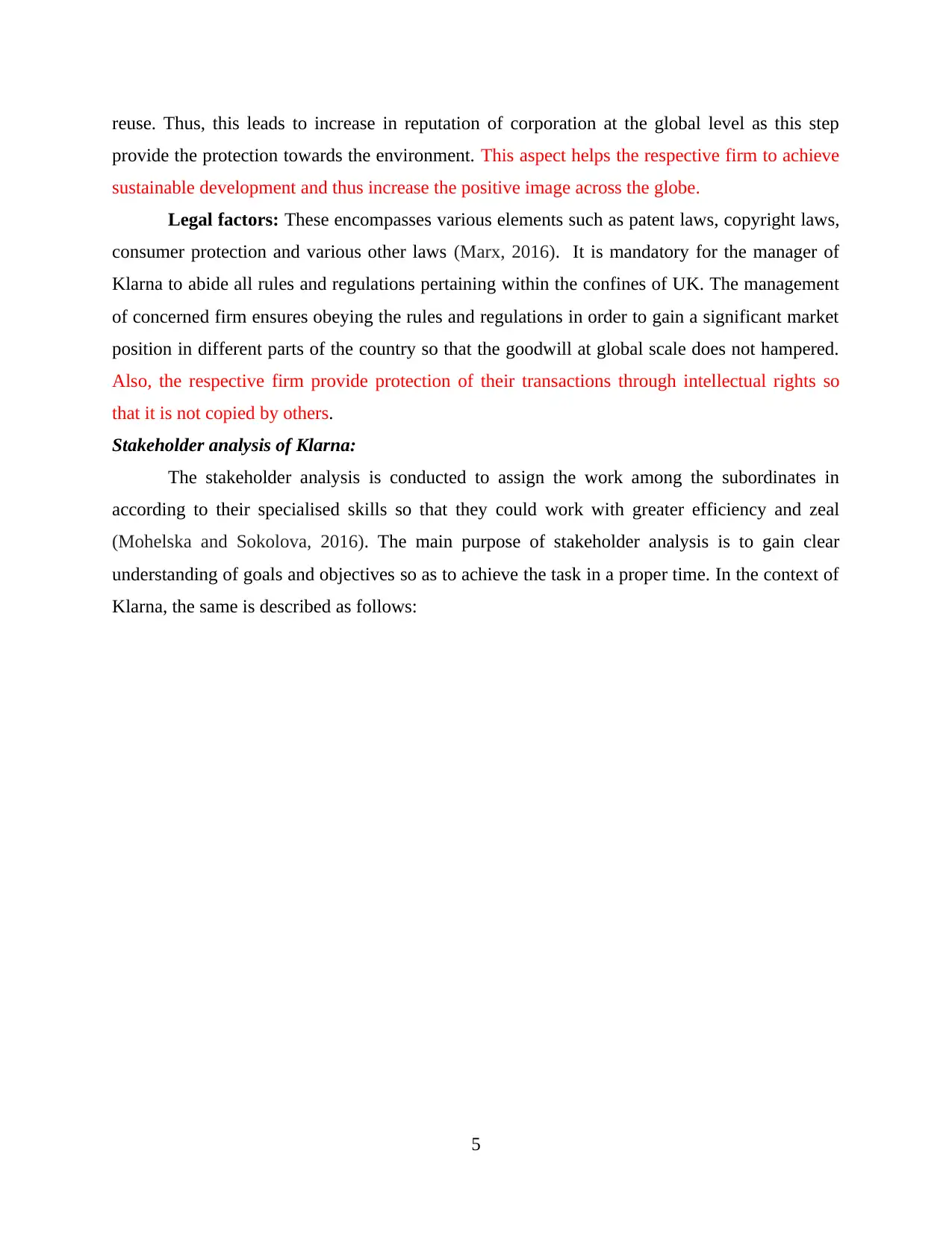
reuse. Thus, this leads to increase in reputation of corporation at the global level as this step
provide the protection towards the environment. This aspect helps the respective firm to achieve
sustainable development and thus increase the positive image across the globe.
Legal factors: These encompasses various elements such as patent laws, copyright laws,
consumer protection and various other laws (Marx, 2016). It is mandatory for the manager of
Klarna to abide all rules and regulations pertaining within the confines of UK. The management
of concerned firm ensures obeying the rules and regulations in order to gain a significant market
position in different parts of the country so that the goodwill at global scale does not hampered.
Also, the respective firm provide protection of their transactions through intellectual rights so
that it is not copied by others.
Stakeholder analysis of Klarna:
The stakeholder analysis is conducted to assign the work among the subordinates in
according to their specialised skills so that they could work with greater efficiency and zeal
(Mohelska and Sokolova, 2016). The main purpose of stakeholder analysis is to gain clear
understanding of goals and objectives so as to achieve the task in a proper time. In the context of
Klarna, the same is described as follows:
5
provide the protection towards the environment. This aspect helps the respective firm to achieve
sustainable development and thus increase the positive image across the globe.
Legal factors: These encompasses various elements such as patent laws, copyright laws,
consumer protection and various other laws (Marx, 2016). It is mandatory for the manager of
Klarna to abide all rules and regulations pertaining within the confines of UK. The management
of concerned firm ensures obeying the rules and regulations in order to gain a significant market
position in different parts of the country so that the goodwill at global scale does not hampered.
Also, the respective firm provide protection of their transactions through intellectual rights so
that it is not copied by others.
Stakeholder analysis of Klarna:
The stakeholder analysis is conducted to assign the work among the subordinates in
according to their specialised skills so that they could work with greater efficiency and zeal
(Mohelska and Sokolova, 2016). The main purpose of stakeholder analysis is to gain clear
understanding of goals and objectives so as to achieve the task in a proper time. In the context of
Klarna, the same is described as follows:
5
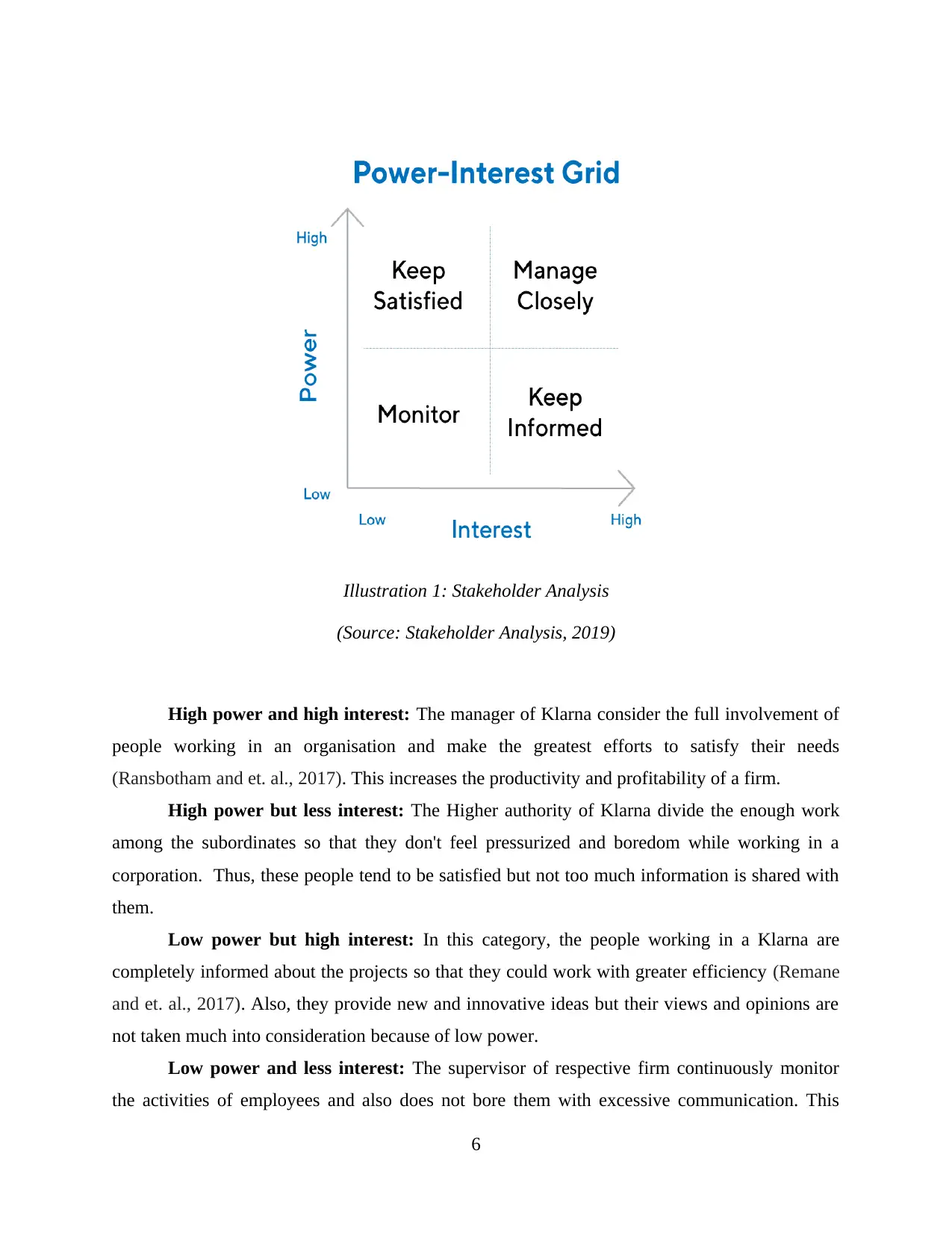
High power and high interest: The manager of Klarna consider the full involvement of
people working in an organisation and make the greatest efforts to satisfy their needs
(Ransbotham and et. al., 2017). This increases the productivity and profitability of a firm.
High power but less interest: The Higher authority of Klarna divide the enough work
among the subordinates so that they don't feel pressurized and boredom while working in a
corporation. Thus, these people tend to be satisfied but not too much information is shared with
them.
Low power but high interest: In this category, the people working in a Klarna are
completely informed about the projects so that they could work with greater efficiency (Remane
and et. al., 2017). Also, they provide new and innovative ideas but their views and opinions are
not taken much into consideration because of low power.
Low power and less interest: The supervisor of respective firm continuously monitor
the activities of employees and also does not bore them with excessive communication. This
6
Illustration 1: Stakeholder Analysis
(Source: Stakeholder Analysis, 2019)
people working in an organisation and make the greatest efforts to satisfy their needs
(Ransbotham and et. al., 2017). This increases the productivity and profitability of a firm.
High power but less interest: The Higher authority of Klarna divide the enough work
among the subordinates so that they don't feel pressurized and boredom while working in a
corporation. Thus, these people tend to be satisfied but not too much information is shared with
them.
Low power but high interest: In this category, the people working in a Klarna are
completely informed about the projects so that they could work with greater efficiency (Remane
and et. al., 2017). Also, they provide new and innovative ideas but their views and opinions are
not taken much into consideration because of low power.
Low power and less interest: The supervisor of respective firm continuously monitor
the activities of employees and also does not bore them with excessive communication. This
6
Illustration 1: Stakeholder Analysis
(Source: Stakeholder Analysis, 2019)
⊘ This is a preview!⊘
Do you want full access?
Subscribe today to unlock all pages.

Trusted by 1+ million students worldwide
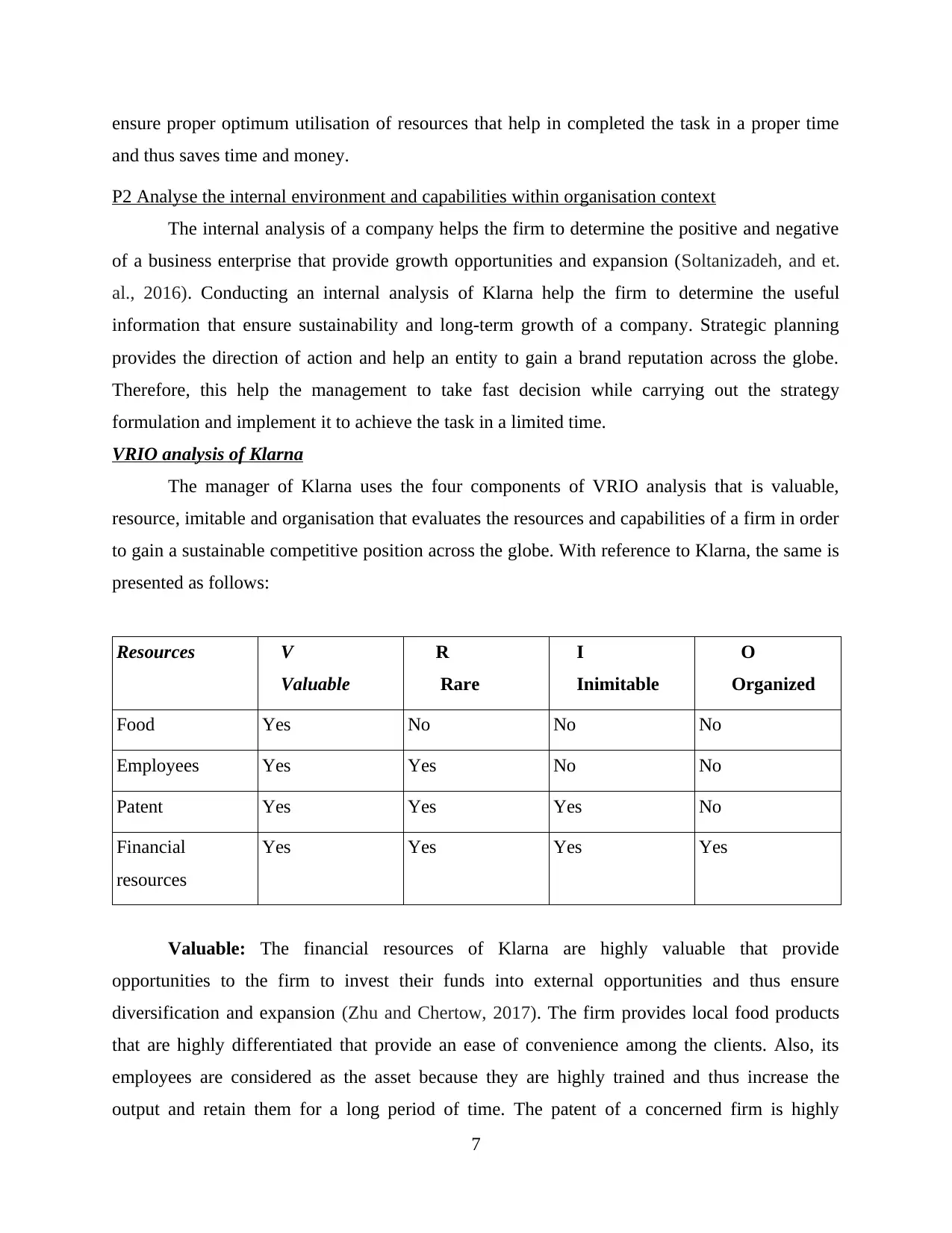
ensure proper optimum utilisation of resources that help in completed the task in a proper time
and thus saves time and money.
P2 Analyse the internal environment and capabilities within organisation context
The internal analysis of a company helps the firm to determine the positive and negative
of a business enterprise that provide growth opportunities and expansion (Soltanizadeh, and et.
al., 2016). Conducting an internal analysis of Klarna help the firm to determine the useful
information that ensure sustainability and long-term growth of a company. Strategic planning
provides the direction of action and help an entity to gain a brand reputation across the globe.
Therefore, this help the management to take fast decision while carrying out the strategy
formulation and implement it to achieve the task in a limited time.
VRIO analysis of Klarna
The manager of Klarna uses the four components of VRIO analysis that is valuable,
resource, imitable and organisation that evaluates the resources and capabilities of a firm in order
to gain a sustainable competitive position across the globe. With reference to Klarna, the same is
presented as follows:
Resources V
Valuable
R
Rare
I
Inimitable
O
Organized
Food Yes No No No
Employees Yes Yes No No
Patent Yes Yes Yes No
Financial
resources
Yes Yes Yes Yes
Valuable: The financial resources of Klarna are highly valuable that provide
opportunities to the firm to invest their funds into external opportunities and thus ensure
diversification and expansion (Zhu and Chertow, 2017). The firm provides local food products
that are highly differentiated that provide an ease of convenience among the clients. Also, its
employees are considered as the asset because they are highly trained and thus increase the
output and retain them for a long period of time. The patent of a concerned firm is highly
7
and thus saves time and money.
P2 Analyse the internal environment and capabilities within organisation context
The internal analysis of a company helps the firm to determine the positive and negative
of a business enterprise that provide growth opportunities and expansion (Soltanizadeh, and et.
al., 2016). Conducting an internal analysis of Klarna help the firm to determine the useful
information that ensure sustainability and long-term growth of a company. Strategic planning
provides the direction of action and help an entity to gain a brand reputation across the globe.
Therefore, this help the management to take fast decision while carrying out the strategy
formulation and implement it to achieve the task in a limited time.
VRIO analysis of Klarna
The manager of Klarna uses the four components of VRIO analysis that is valuable,
resource, imitable and organisation that evaluates the resources and capabilities of a firm in order
to gain a sustainable competitive position across the globe. With reference to Klarna, the same is
presented as follows:
Resources V
Valuable
R
Rare
I
Inimitable
O
Organized
Food Yes No No No
Employees Yes Yes No No
Patent Yes Yes Yes No
Financial
resources
Yes Yes Yes Yes
Valuable: The financial resources of Klarna are highly valuable that provide
opportunities to the firm to invest their funds into external opportunities and thus ensure
diversification and expansion (Zhu and Chertow, 2017). The firm provides local food products
that are highly differentiated that provide an ease of convenience among the clients. Also, its
employees are considered as the asset because they are highly trained and thus increase the
output and retain them for a long period of time. The patent of a concerned firm is highly
7
Paraphrase This Document
Need a fresh take? Get an instant paraphrase of this document with our AI Paraphraser
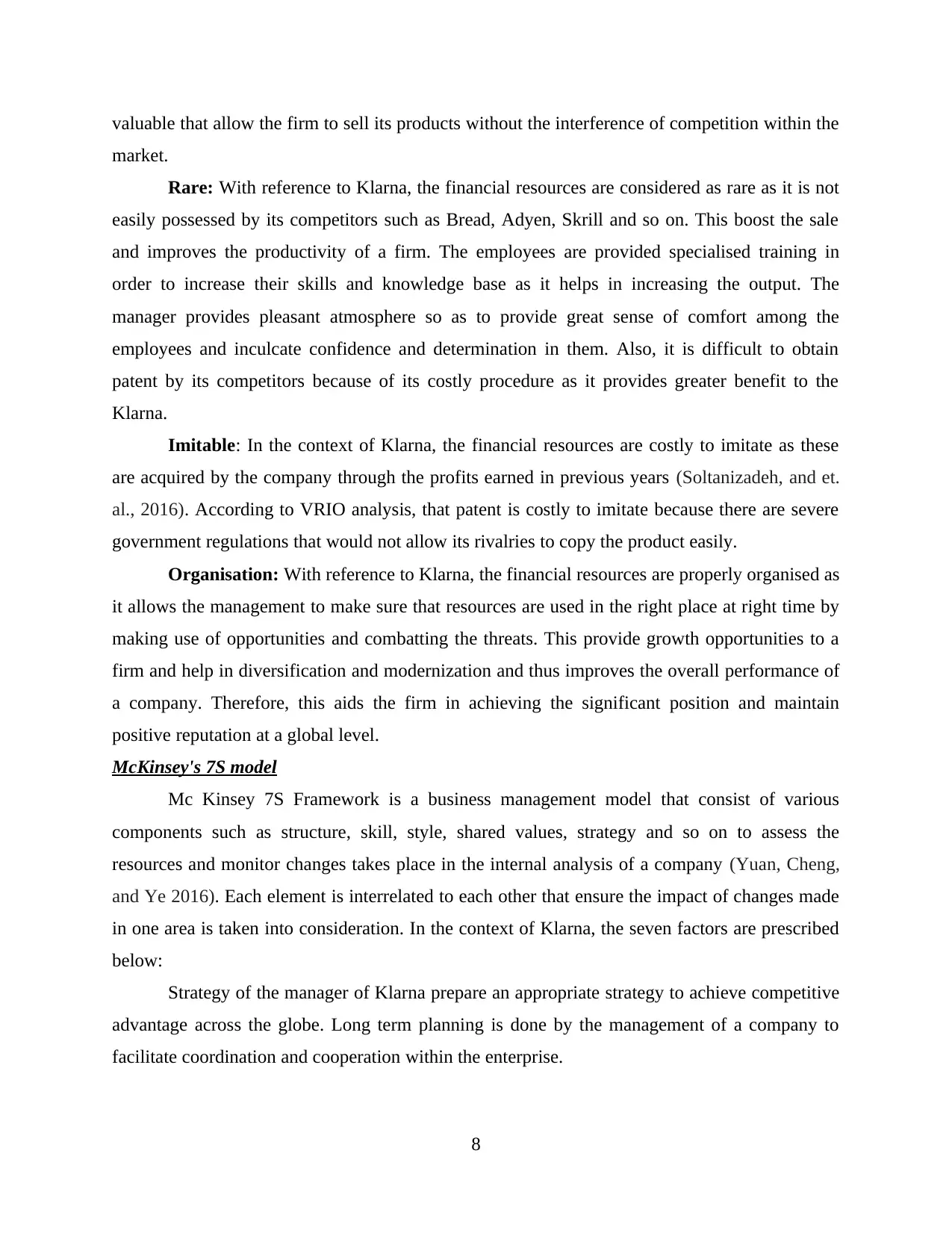
valuable that allow the firm to sell its products without the interference of competition within the
market.
Rare: With reference to Klarna, the financial resources are considered as rare as it is not
easily possessed by its competitors such as Bread, Adyen, Skrill and so on. This boost the sale
and improves the productivity of a firm. The employees are provided specialised training in
order to increase their skills and knowledge base as it helps in increasing the output. The
manager provides pleasant atmosphere so as to provide great sense of comfort among the
employees and inculcate confidence and determination in them. Also, it is difficult to obtain
patent by its competitors because of its costly procedure as it provides greater benefit to the
Klarna.
Imitable: In the context of Klarna, the financial resources are costly to imitate as these
are acquired by the company through the profits earned in previous years (Soltanizadeh, and et.
al., 2016). According to VRIO analysis, that patent is costly to imitate because there are severe
government regulations that would not allow its rivalries to copy the product easily.
Organisation: With reference to Klarna, the financial resources are properly organised as
it allows the management to make sure that resources are used in the right place at right time by
making use of opportunities and combatting the threats. This provide growth opportunities to a
firm and help in diversification and modernization and thus improves the overall performance of
a company. Therefore, this aids the firm in achieving the significant position and maintain
positive reputation at a global level.
McKinsey's 7S model
Mc Kinsey 7S Framework is a business management model that consist of various
components such as structure, skill, style, shared values, strategy and so on to assess the
resources and monitor changes takes place in the internal analysis of a company (Yuan, Cheng,
and Ye 2016). Each element is interrelated to each other that ensure the impact of changes made
in one area is taken into consideration. In the context of Klarna, the seven factors are prescribed
below:
Strategy of the manager of Klarna prepare an appropriate strategy to achieve competitive
advantage across the globe. Long term planning is done by the management of a company to
facilitate coordination and cooperation within the enterprise.
8
market.
Rare: With reference to Klarna, the financial resources are considered as rare as it is not
easily possessed by its competitors such as Bread, Adyen, Skrill and so on. This boost the sale
and improves the productivity of a firm. The employees are provided specialised training in
order to increase their skills and knowledge base as it helps in increasing the output. The
manager provides pleasant atmosphere so as to provide great sense of comfort among the
employees and inculcate confidence and determination in them. Also, it is difficult to obtain
patent by its competitors because of its costly procedure as it provides greater benefit to the
Klarna.
Imitable: In the context of Klarna, the financial resources are costly to imitate as these
are acquired by the company through the profits earned in previous years (Soltanizadeh, and et.
al., 2016). According to VRIO analysis, that patent is costly to imitate because there are severe
government regulations that would not allow its rivalries to copy the product easily.
Organisation: With reference to Klarna, the financial resources are properly organised as
it allows the management to make sure that resources are used in the right place at right time by
making use of opportunities and combatting the threats. This provide growth opportunities to a
firm and help in diversification and modernization and thus improves the overall performance of
a company. Therefore, this aids the firm in achieving the significant position and maintain
positive reputation at a global level.
McKinsey's 7S model
Mc Kinsey 7S Framework is a business management model that consist of various
components such as structure, skill, style, shared values, strategy and so on to assess the
resources and monitor changes takes place in the internal analysis of a company (Yuan, Cheng,
and Ye 2016). Each element is interrelated to each other that ensure the impact of changes made
in one area is taken into consideration. In the context of Klarna, the seven factors are prescribed
below:
Strategy of the manager of Klarna prepare an appropriate strategy to achieve competitive
advantage across the globe. Long term planning is done by the management of a company to
facilitate coordination and cooperation within the enterprise.
8
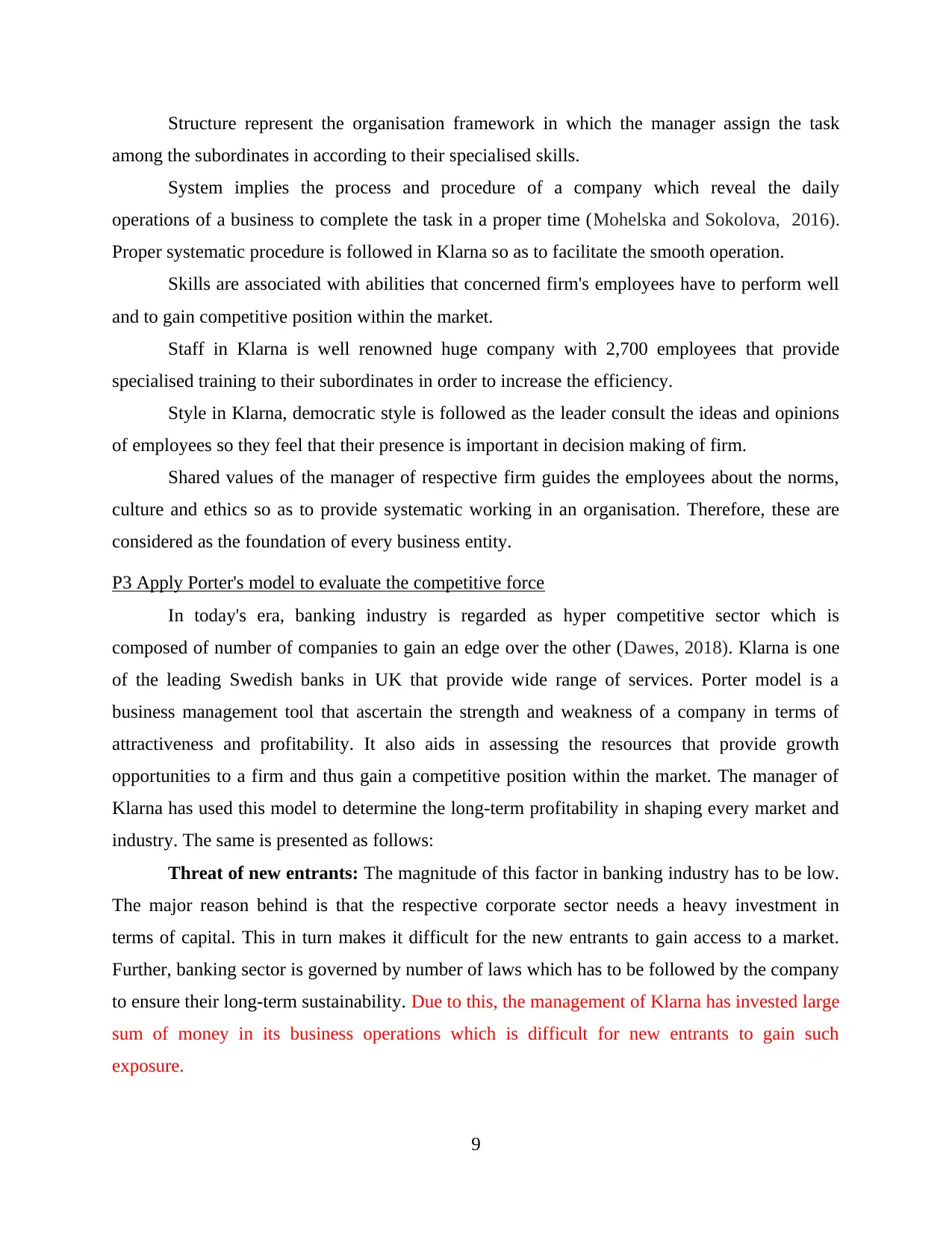
Structure represent the organisation framework in which the manager assign the task
among the subordinates in according to their specialised skills.
System implies the process and procedure of a company which reveal the daily
operations of a business to complete the task in a proper time (Mohelska and Sokolova, 2016).
Proper systematic procedure is followed in Klarna so as to facilitate the smooth operation.
Skills are associated with abilities that concerned firm's employees have to perform well
and to gain competitive position within the market.
Staff in Klarna is well renowned huge company with 2,700 employees that provide
specialised training to their subordinates in order to increase the efficiency.
Style in Klarna, democratic style is followed as the leader consult the ideas and opinions
of employees so they feel that their presence is important in decision making of firm.
Shared values of the manager of respective firm guides the employees about the norms,
culture and ethics so as to provide systematic working in an organisation. Therefore, these are
considered as the foundation of every business entity.
P3 Apply Porter's model to evaluate the competitive force
In today's era, banking industry is regarded as hyper competitive sector which is
composed of number of companies to gain an edge over the other (Dawes, 2018). Klarna is one
of the leading Swedish banks in UK that provide wide range of services. Porter model is a
business management tool that ascertain the strength and weakness of a company in terms of
attractiveness and profitability. It also aids in assessing the resources that provide growth
opportunities to a firm and thus gain a competitive position within the market. The manager of
Klarna has used this model to determine the long-term profitability in shaping every market and
industry. The same is presented as follows:
Threat of new entrants: The magnitude of this factor in banking industry has to be low.
The major reason behind is that the respective corporate sector needs a heavy investment in
terms of capital. This in turn makes it difficult for the new entrants to gain access to a market.
Further, banking sector is governed by number of laws which has to be followed by the company
to ensure their long-term sustainability. Due to this, the management of Klarna has invested large
sum of money in its business operations which is difficult for new entrants to gain such
exposure.
9
among the subordinates in according to their specialised skills.
System implies the process and procedure of a company which reveal the daily
operations of a business to complete the task in a proper time (Mohelska and Sokolova, 2016).
Proper systematic procedure is followed in Klarna so as to facilitate the smooth operation.
Skills are associated with abilities that concerned firm's employees have to perform well
and to gain competitive position within the market.
Staff in Klarna is well renowned huge company with 2,700 employees that provide
specialised training to their subordinates in order to increase the efficiency.
Style in Klarna, democratic style is followed as the leader consult the ideas and opinions
of employees so they feel that their presence is important in decision making of firm.
Shared values of the manager of respective firm guides the employees about the norms,
culture and ethics so as to provide systematic working in an organisation. Therefore, these are
considered as the foundation of every business entity.
P3 Apply Porter's model to evaluate the competitive force
In today's era, banking industry is regarded as hyper competitive sector which is
composed of number of companies to gain an edge over the other (Dawes, 2018). Klarna is one
of the leading Swedish banks in UK that provide wide range of services. Porter model is a
business management tool that ascertain the strength and weakness of a company in terms of
attractiveness and profitability. It also aids in assessing the resources that provide growth
opportunities to a firm and thus gain a competitive position within the market. The manager of
Klarna has used this model to determine the long-term profitability in shaping every market and
industry. The same is presented as follows:
Threat of new entrants: The magnitude of this factor in banking industry has to be low.
The major reason behind is that the respective corporate sector needs a heavy investment in
terms of capital. This in turn makes it difficult for the new entrants to gain access to a market.
Further, banking sector is governed by number of laws which has to be followed by the company
to ensure their long-term sustainability. Due to this, the management of Klarna has invested large
sum of money in its business operations which is difficult for new entrants to gain such
exposure.
9
⊘ This is a preview!⊘
Do you want full access?
Subscribe today to unlock all pages.

Trusted by 1+ million students worldwide
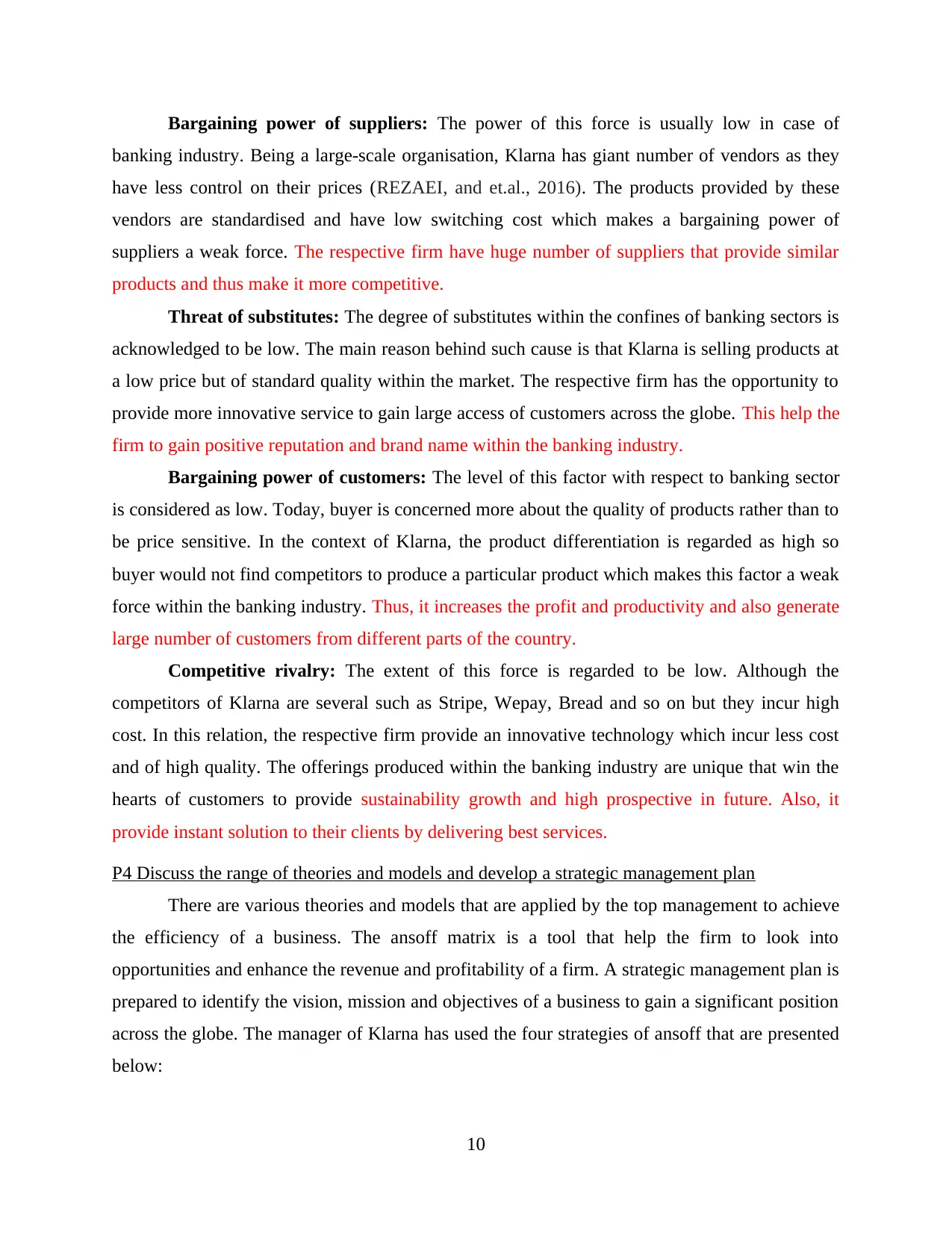
Bargaining power of suppliers: The power of this force is usually low in case of
banking industry. Being a large-scale organisation, Klarna has giant number of vendors as they
have less control on their prices (REZAEI, and et.al., 2016). The products provided by these
vendors are standardised and have low switching cost which makes a bargaining power of
suppliers a weak force. The respective firm have huge number of suppliers that provide similar
products and thus make it more competitive.
Threat of substitutes: The degree of substitutes within the confines of banking sectors is
acknowledged to be low. The main reason behind such cause is that Klarna is selling products at
a low price but of standard quality within the market. The respective firm has the opportunity to
provide more innovative service to gain large access of customers across the globe. This help the
firm to gain positive reputation and brand name within the banking industry.
Bargaining power of customers: The level of this factor with respect to banking sector
is considered as low. Today, buyer is concerned more about the quality of products rather than to
be price sensitive. In the context of Klarna, the product differentiation is regarded as high so
buyer would not find competitors to produce a particular product which makes this factor a weak
force within the banking industry. Thus, it increases the profit and productivity and also generate
large number of customers from different parts of the country.
Competitive rivalry: The extent of this force is regarded to be low. Although the
competitors of Klarna are several such as Stripe, Wepay, Bread and so on but they incur high
cost. In this relation, the respective firm provide an innovative technology which incur less cost
and of high quality. The offerings produced within the banking industry are unique that win the
hearts of customers to provide sustainability growth and high prospective in future. Also, it
provide instant solution to their clients by delivering best services.
P4 Discuss the range of theories and models and develop a strategic management plan
There are various theories and models that are applied by the top management to achieve
the efficiency of a business. The ansoff matrix is a tool that help the firm to look into
opportunities and enhance the revenue and profitability of a firm. A strategic management plan is
prepared to identify the vision, mission and objectives of a business to gain a significant position
across the globe. The manager of Klarna has used the four strategies of ansoff that are presented
below:
10
banking industry. Being a large-scale organisation, Klarna has giant number of vendors as they
have less control on their prices (REZAEI, and et.al., 2016). The products provided by these
vendors are standardised and have low switching cost which makes a bargaining power of
suppliers a weak force. The respective firm have huge number of suppliers that provide similar
products and thus make it more competitive.
Threat of substitutes: The degree of substitutes within the confines of banking sectors is
acknowledged to be low. The main reason behind such cause is that Klarna is selling products at
a low price but of standard quality within the market. The respective firm has the opportunity to
provide more innovative service to gain large access of customers across the globe. This help the
firm to gain positive reputation and brand name within the banking industry.
Bargaining power of customers: The level of this factor with respect to banking sector
is considered as low. Today, buyer is concerned more about the quality of products rather than to
be price sensitive. In the context of Klarna, the product differentiation is regarded as high so
buyer would not find competitors to produce a particular product which makes this factor a weak
force within the banking industry. Thus, it increases the profit and productivity and also generate
large number of customers from different parts of the country.
Competitive rivalry: The extent of this force is regarded to be low. Although the
competitors of Klarna are several such as Stripe, Wepay, Bread and so on but they incur high
cost. In this relation, the respective firm provide an innovative technology which incur less cost
and of high quality. The offerings produced within the banking industry are unique that win the
hearts of customers to provide sustainability growth and high prospective in future. Also, it
provide instant solution to their clients by delivering best services.
P4 Discuss the range of theories and models and develop a strategic management plan
There are various theories and models that are applied by the top management to achieve
the efficiency of a business. The ansoff matrix is a tool that help the firm to look into
opportunities and enhance the revenue and profitability of a firm. A strategic management plan is
prepared to identify the vision, mission and objectives of a business to gain a significant position
across the globe. The manager of Klarna has used the four strategies of ansoff that are presented
below:
10
Paraphrase This Document
Need a fresh take? Get an instant paraphrase of this document with our AI Paraphraser
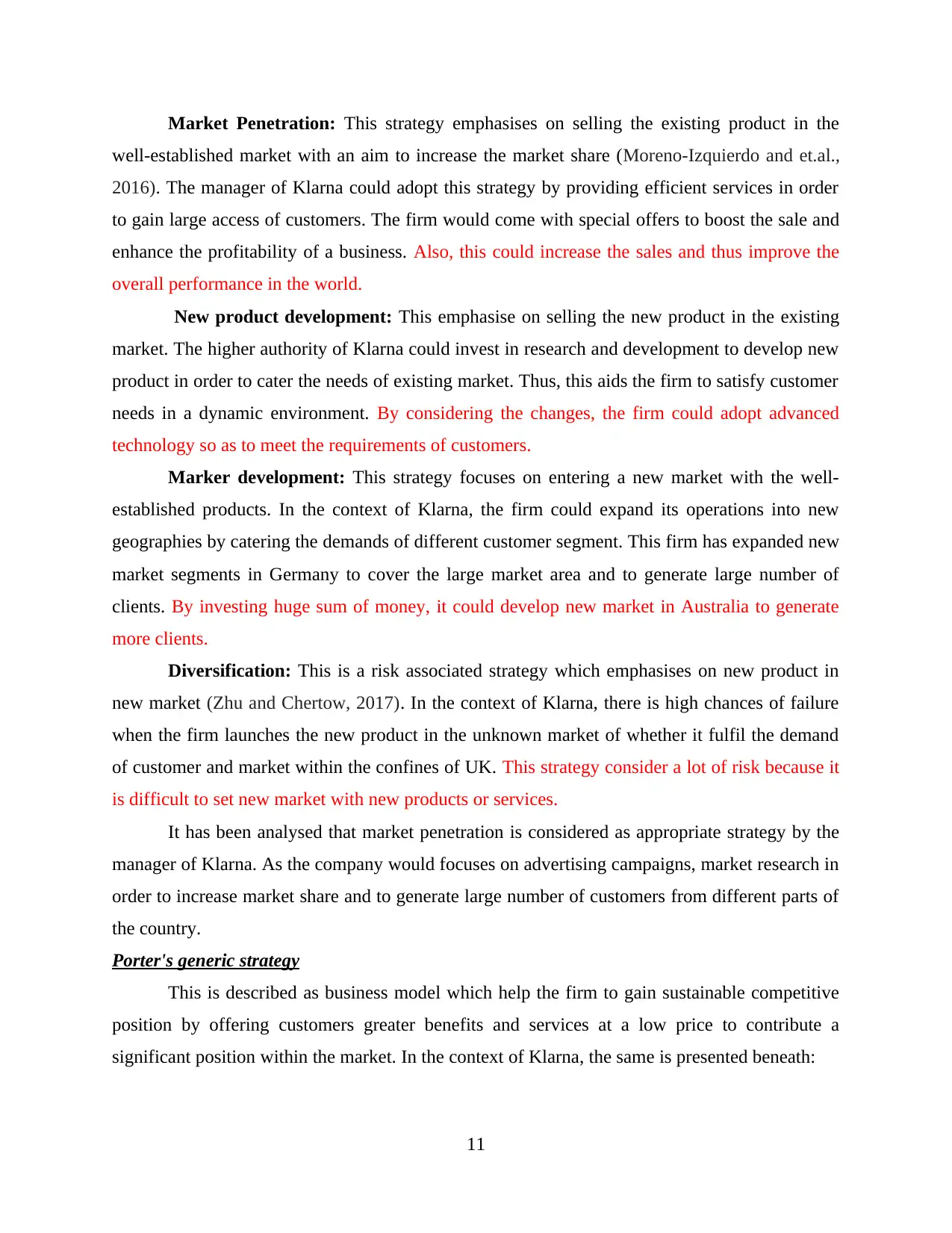
Market Penetration: This strategy emphasises on selling the existing product in the
well-established market with an aim to increase the market share (Moreno-Izquierdo and et.al.,
2016). The manager of Klarna could adopt this strategy by providing efficient services in order
to gain large access of customers. The firm would come with special offers to boost the sale and
enhance the profitability of a business. Also, this could increase the sales and thus improve the
overall performance in the world.
New product development: This emphasise on selling the new product in the existing
market. The higher authority of Klarna could invest in research and development to develop new
product in order to cater the needs of existing market. Thus, this aids the firm to satisfy customer
needs in a dynamic environment. By considering the changes, the firm could adopt advanced
technology so as to meet the requirements of customers.
Marker development: This strategy focuses on entering a new market with the well-
established products. In the context of Klarna, the firm could expand its operations into new
geographies by catering the demands of different customer segment. This firm has expanded new
market segments in Germany to cover the large market area and to generate large number of
clients. By investing huge sum of money, it could develop new market in Australia to generate
more clients.
Diversification: This is a risk associated strategy which emphasises on new product in
new market (Zhu and Chertow, 2017). In the context of Klarna, there is high chances of failure
when the firm launches the new product in the unknown market of whether it fulfil the demand
of customer and market within the confines of UK. This strategy consider a lot of risk because it
is difficult to set new market with new products or services.
It has been analysed that market penetration is considered as appropriate strategy by the
manager of Klarna. As the company would focuses on advertising campaigns, market research in
order to increase market share and to generate large number of customers from different parts of
the country.
Porter's generic strategy
This is described as business model which help the firm to gain sustainable competitive
position by offering customers greater benefits and services at a low price to contribute a
significant position within the market. In the context of Klarna, the same is presented beneath:
11
well-established market with an aim to increase the market share (Moreno-Izquierdo and et.al.,
2016). The manager of Klarna could adopt this strategy by providing efficient services in order
to gain large access of customers. The firm would come with special offers to boost the sale and
enhance the profitability of a business. Also, this could increase the sales and thus improve the
overall performance in the world.
New product development: This emphasise on selling the new product in the existing
market. The higher authority of Klarna could invest in research and development to develop new
product in order to cater the needs of existing market. Thus, this aids the firm to satisfy customer
needs in a dynamic environment. By considering the changes, the firm could adopt advanced
technology so as to meet the requirements of customers.
Marker development: This strategy focuses on entering a new market with the well-
established products. In the context of Klarna, the firm could expand its operations into new
geographies by catering the demands of different customer segment. This firm has expanded new
market segments in Germany to cover the large market area and to generate large number of
clients. By investing huge sum of money, it could develop new market in Australia to generate
more clients.
Diversification: This is a risk associated strategy which emphasises on new product in
new market (Zhu and Chertow, 2017). In the context of Klarna, there is high chances of failure
when the firm launches the new product in the unknown market of whether it fulfil the demand
of customer and market within the confines of UK. This strategy consider a lot of risk because it
is difficult to set new market with new products or services.
It has been analysed that market penetration is considered as appropriate strategy by the
manager of Klarna. As the company would focuses on advertising campaigns, market research in
order to increase market share and to generate large number of customers from different parts of
the country.
Porter's generic strategy
This is described as business model which help the firm to gain sustainable competitive
position by offering customers greater benefits and services at a low price to contribute a
significant position within the market. In the context of Klarna, the same is presented beneath:
11
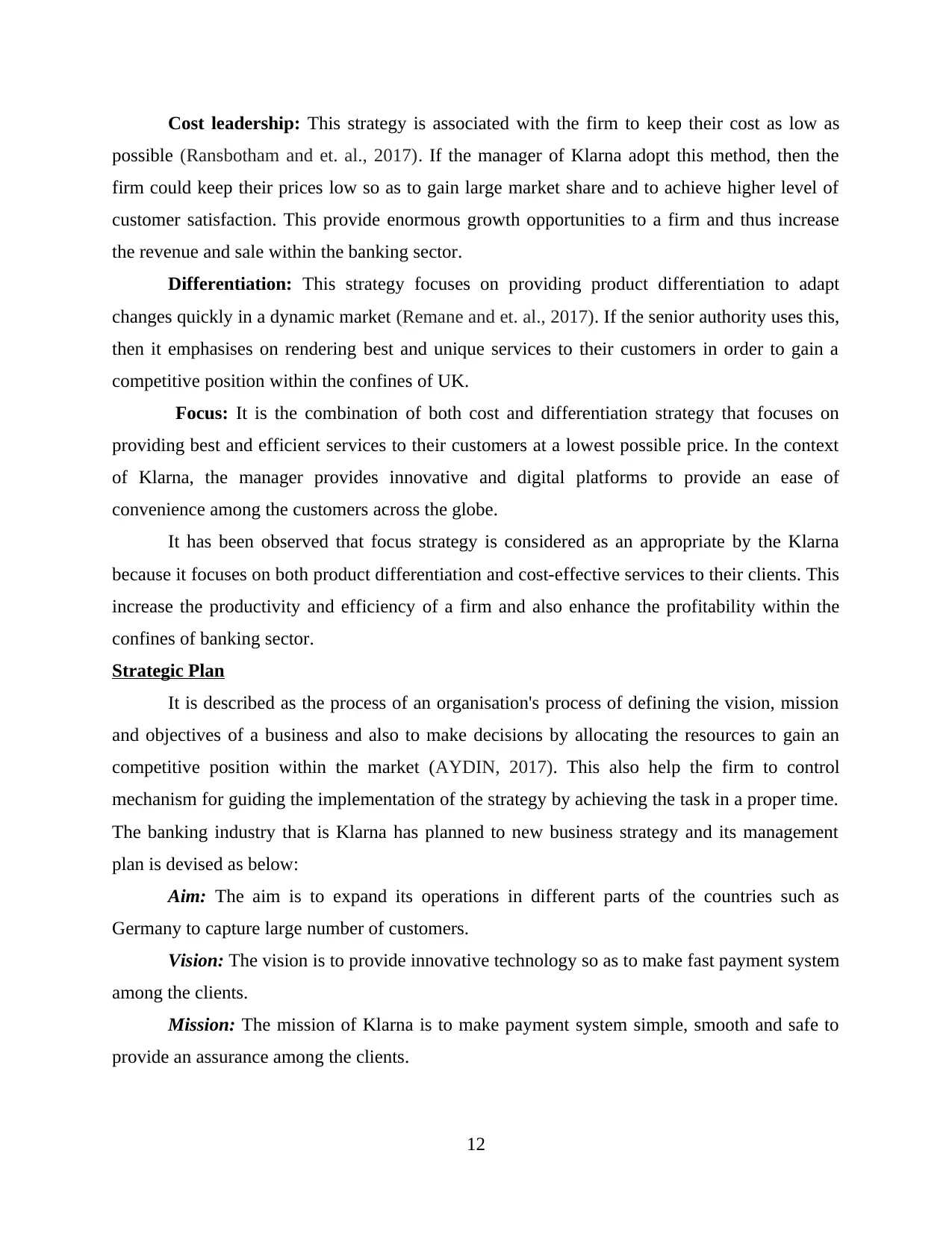
Cost leadership: This strategy is associated with the firm to keep their cost as low as
possible (Ransbotham and et. al., 2017). If the manager of Klarna adopt this method, then the
firm could keep their prices low so as to gain large market share and to achieve higher level of
customer satisfaction. This provide enormous growth opportunities to a firm and thus increase
the revenue and sale within the banking sector.
Differentiation: This strategy focuses on providing product differentiation to adapt
changes quickly in a dynamic market (Remane and et. al., 2017). If the senior authority uses this,
then it emphasises on rendering best and unique services to their customers in order to gain a
competitive position within the confines of UK.
Focus: It is the combination of both cost and differentiation strategy that focuses on
providing best and efficient services to their customers at a lowest possible price. In the context
of Klarna, the manager provides innovative and digital platforms to provide an ease of
convenience among the customers across the globe.
It has been observed that focus strategy is considered as an appropriate by the Klarna
because it focuses on both product differentiation and cost-effective services to their clients. This
increase the productivity and efficiency of a firm and also enhance the profitability within the
confines of banking sector.
Strategic Plan
It is described as the process of an organisation's process of defining the vision, mission
and objectives of a business and also to make decisions by allocating the resources to gain an
competitive position within the market (AYDIN, 2017). This also help the firm to control
mechanism for guiding the implementation of the strategy by achieving the task in a proper time.
The banking industry that is Klarna has planned to new business strategy and its management
plan is devised as below:
Aim: The aim is to expand its operations in different parts of the countries such as
Germany to capture large number of customers.
Vision: The vision is to provide innovative technology so as to make fast payment system
among the clients.
Mission: The mission of Klarna is to make payment system simple, smooth and safe to
provide an assurance among the clients.
12
possible (Ransbotham and et. al., 2017). If the manager of Klarna adopt this method, then the
firm could keep their prices low so as to gain large market share and to achieve higher level of
customer satisfaction. This provide enormous growth opportunities to a firm and thus increase
the revenue and sale within the banking sector.
Differentiation: This strategy focuses on providing product differentiation to adapt
changes quickly in a dynamic market (Remane and et. al., 2017). If the senior authority uses this,
then it emphasises on rendering best and unique services to their customers in order to gain a
competitive position within the confines of UK.
Focus: It is the combination of both cost and differentiation strategy that focuses on
providing best and efficient services to their customers at a lowest possible price. In the context
of Klarna, the manager provides innovative and digital platforms to provide an ease of
convenience among the customers across the globe.
It has been observed that focus strategy is considered as an appropriate by the Klarna
because it focuses on both product differentiation and cost-effective services to their clients. This
increase the productivity and efficiency of a firm and also enhance the profitability within the
confines of banking sector.
Strategic Plan
It is described as the process of an organisation's process of defining the vision, mission
and objectives of a business and also to make decisions by allocating the resources to gain an
competitive position within the market (AYDIN, 2017). This also help the firm to control
mechanism for guiding the implementation of the strategy by achieving the task in a proper time.
The banking industry that is Klarna has planned to new business strategy and its management
plan is devised as below:
Aim: The aim is to expand its operations in different parts of the countries such as
Germany to capture large number of customers.
Vision: The vision is to provide innovative technology so as to make fast payment system
among the clients.
Mission: The mission of Klarna is to make payment system simple, smooth and safe to
provide an assurance among the clients.
12
⊘ This is a preview!⊘
Do you want full access?
Subscribe today to unlock all pages.

Trusted by 1+ million students worldwide
1 out of 17
Related Documents
Your All-in-One AI-Powered Toolkit for Academic Success.
+13062052269
info@desklib.com
Available 24*7 on WhatsApp / Email
![[object Object]](/_next/static/media/star-bottom.7253800d.svg)
Unlock your academic potential
Copyright © 2020–2025 A2Z Services. All Rights Reserved. Developed and managed by ZUCOL.




